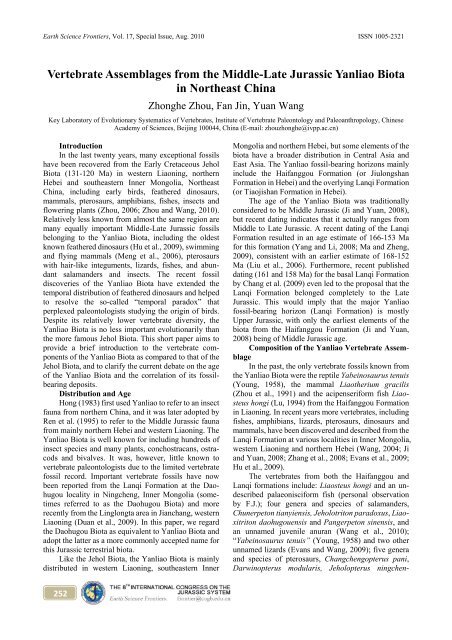in Jurassic and Cretaceous Stratigraphy
in Jurassic and Cretaceous Stratigraphy
in Jurassic and Cretaceous Stratigraphy
Create successful ePaper yourself
Turn your PDF publications into a flip-book with our unique Google optimized e-Paper software.
Earth Science Frontiers, Vol. 17, Special Issue, Aug. 2010 ISSN 1005-2321<br />
Vertebrate Assemblages from the Middle-Late <strong>Jurassic</strong> Yanliao Biota<br />
<strong>in</strong> Northeast Ch<strong>in</strong>a<br />
252<br />
Zhonghe Zhou, Fan J<strong>in</strong>, Yuan Wang<br />
Key Laboratory of Evolutionary Systematics of Vertebrates, Institute of Vertebrate Paleontology <strong>and</strong> Paleoanthropology, Ch<strong>in</strong>ese<br />
Academy of Sciences, Beij<strong>in</strong>g 100044, Ch<strong>in</strong>a (E-mail: zhouzhonghe@ivpp.ac.cn)<br />
Introduction<br />
In the last twenty years, many exceptional fossils<br />
have been recovered from the Early <strong>Cretaceous</strong> Jehol<br />
Biota (131-120 Ma) <strong>in</strong> western Liaon<strong>in</strong>g, northern<br />
Hebei <strong>and</strong> southeastern Inner Mongolia, Northeast<br />
Ch<strong>in</strong>a, <strong>in</strong>clud<strong>in</strong>g early birds, feathered d<strong>in</strong>osaurs,<br />
mammals, pterosaurs, amphibians, fishes, <strong>in</strong>sects <strong>and</strong><br />
flower<strong>in</strong>g plants (Zhou, 2006; Zhou <strong>and</strong> Wang, 2010).<br />
Relatively less known from almost the same region are<br />
many equally important Middle-Late <strong>Jurassic</strong> fossils<br />
belong<strong>in</strong>g to the Yanliao Biota, <strong>in</strong>clud<strong>in</strong>g the oldest<br />
known feathered d<strong>in</strong>osaurs (Hu et al., 2009), swimm<strong>in</strong>g<br />
<strong>and</strong> fly<strong>in</strong>g mammals (Meng et al., 2006), pterosaurs<br />
with hair-like <strong>in</strong>teguments, lizards, fishes, <strong>and</strong> abun-<br />
dant salam<strong>and</strong>ers <strong>and</strong> <strong>in</strong>sects. The recent fossil<br />
discoveries of the Yanliao Biota have extended the<br />
temporal distribution of feathered d<strong>in</strong>osaurs <strong>and</strong> helped<br />
to resolve the so-called “temporal paradox” that<br />
perplexed paleontologists study<strong>in</strong>g the orig<strong>in</strong> of birds.<br />
Despite its relatively lower vertebrate diversity, the<br />
Yanliao Biota is no less important evolutionarily than<br />
the more famous Jehol Biota. This short paper aims to<br />
provide a brief <strong>in</strong>troduction to the vertebrate com-<br />
ponents of the Yanliao Biota as compared to that of the<br />
Jehol Biota, <strong>and</strong> to clarify the current debate on the age<br />
of the Yanliao Biota <strong>and</strong> the correlation of its fossil-<br />
bear<strong>in</strong>g deposits.<br />
Distribution <strong>and</strong> Age<br />
Hong (1983) first used Yanliao to refer to an <strong>in</strong>sect<br />
fauna from northern Ch<strong>in</strong>a, <strong>and</strong> it was later adopted by<br />
Ren et al. (1995) to refer to the Middle <strong>Jurassic</strong> fauna<br />
from ma<strong>in</strong>ly northern Hebei <strong>and</strong> western Liaon<strong>in</strong>g. The<br />
Yanliao Biota is well known for <strong>in</strong>clud<strong>in</strong>g hundreds of<br />
<strong>in</strong>sect species <strong>and</strong> many plants, conchostracans, ostra-<br />
cods <strong>and</strong> bivalves. It was, however, little known to<br />
vertebrate paleontologists due to the limited vertebrate<br />
fossil record. Important vertebrate fossils have now<br />
been reported from the Lanqi Formation at the Dao-<br />
hugou locality <strong>in</strong> N<strong>in</strong>gcheng, Inner Mongolia (some-<br />
times referred to as the Daohugou Biota) <strong>and</strong> more<br />
recently from the L<strong>in</strong>glongta area <strong>in</strong> Jianchang, western<br />
Liaon<strong>in</strong>g (Duan et al., 2009). In this paper, we regard<br />
the Daohugou Biota as equivalent to Yanliao Biota <strong>and</strong><br />
adopt the latter as a more commonly accepted name for<br />
this <strong>Jurassic</strong> terrestrial biota.<br />
Like the Jehol Biota, the Yanliao Biota is ma<strong>in</strong>ly<br />
distributed <strong>in</strong> western Liaon<strong>in</strong>g, southeastern Inner<br />
Mongolia <strong>and</strong> northern Hebei, but some elements of the<br />
biota have a broader distribution <strong>in</strong> Central Asia <strong>and</strong><br />
East Asia. The Yanliao fossil-bear<strong>in</strong>g horizons ma<strong>in</strong>ly<br />
<strong>in</strong>clude the Haifanggou Formation (or Jiulongshan<br />
Formation <strong>in</strong> Hebei) <strong>and</strong> the overly<strong>in</strong>g Lanqi Formation<br />
(or Tiaojishan Formation <strong>in</strong> Hebei).<br />
The age of the Yanliao Biota was traditionally<br />
considered to be Middle <strong>Jurassic</strong> (Ji <strong>and</strong> Yuan, 2008),<br />
but recent dat<strong>in</strong>g <strong>in</strong>dicates that it actually ranges from<br />
Middle to Late <strong>Jurassic</strong>. A recent dat<strong>in</strong>g of the Lanqi<br />
Formation resulted <strong>in</strong> an age estimate of 166-153 Ma<br />
for this formation (Yang <strong>and</strong> Li, 2008; Ma <strong>and</strong> Zheng,<br />
2009), consistent with an earlier estimate of 168-152<br />
Ma (Liu et al., 2006). Furthermore, recent published<br />
dat<strong>in</strong>g (161 <strong>and</strong> 158 Ma) for the basal Lanqi Formation<br />
by Chang et al. (2009) even led to the proposal that the<br />
Lanqi Formation belonged completely to the Late<br />
<strong>Jurassic</strong>. This would imply that the major Yanliao<br />
fossil-bear<strong>in</strong>g horizon (Lanqi Formation) is mostly<br />
Upper <strong>Jurassic</strong>, with only the earliest elements of the<br />
biota from the Haifanggou Formation (Ji <strong>and</strong> Yuan,<br />
2008) be<strong>in</strong>g of Middle <strong>Jurassic</strong> age.<br />
Composition of the Yanliao Vertebrate Assem-<br />
blage<br />
In the past, the only vertebrate fossils known from<br />
the Yanliao Biota were the reptile Yabe<strong>in</strong>osaurus tenuis<br />
(Young, 1958), the mammal Liaotherium gracilis<br />
(Zhou et al., 1991) <strong>and</strong> the acipenseriform fish Liao-<br />
steus hongi (Lu, 1994) from the Haifanggou Formation<br />
<strong>in</strong> Liaon<strong>in</strong>g. In recent years more vertebrates, <strong>in</strong>clud<strong>in</strong>g<br />
fishes, amphibians, lizards, pterosaurs, d<strong>in</strong>osaurs <strong>and</strong><br />
mammals, have been discovered <strong>and</strong> described from the<br />
Lanqi Formation at various localities <strong>in</strong> Inner Mongolia,<br />
western Liaon<strong>in</strong>g <strong>and</strong> northern Hebei (Wang, 2004; Ji<br />
<strong>and</strong> Yuan, 2008; Zhang et al., 2008; Evans et al., 2009;<br />
Hu et al., 2009).<br />
The vertebrates from both the Haifanggou <strong>and</strong><br />
Lanqi formations <strong>in</strong>clude: Liaosteus hongi <strong>and</strong> an un-<br />
described palaeonisciform fish (personal observation<br />
by F.J.); four genera <strong>and</strong> species of salam<strong>and</strong>ers,<br />
Chunerpeton tianyiensis, Jeholotriton paradoxus, Liao-<br />
xitriton daohugouensis <strong>and</strong> Pangerpeton s<strong>in</strong>ensis, <strong>and</strong><br />
an unnamed juvenile anuran (Wang et al., 2010);<br />
“Yabe<strong>in</strong>osaurus tenuis” (Young, 1958) <strong>and</strong> two other<br />
unnamed lizards (Evans <strong>and</strong> Wang, 2009); five genera<br />
<strong>and</strong> species of pterosaurs, Changchengopterus pani,<br />
Darw<strong>in</strong>opterus modularis, Jeholopterus n<strong>in</strong>gchen-

















